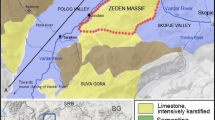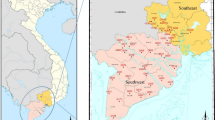Abstract
U-modeled groundwater residence times were estimated by changes in 234U/238U activity ratio (AR) and U content of groundwaters from Poços de Caldas city situated at the Poços de Caldas alkaline massif, Brazil. The estimated ages are more realistic than others generated by the use of hydraulic conductivity data and available information about the weathering rate of rocks in the plateau. The 234U/238U AR and reciprocal of the dissolved U-content data also defined a ternary plot that allowed the calculation of the relative volume of three source waters for the mixed water. Such U-isotopes modeling for mixing calculations indicated that the dominant phase (68%) in the mixture is thermal.










Similar content being viewed by others
References
Almeida Filho R, Paradella WR (1977) Investigating the Poços de Caldas alkaline massif through Landsat images emphasizing radioactive mineralizations. Instituto Nacional de Pesquisas Espaciais, São José dos Campos, Rep 11/2-TPT/065
Amaral ECS, Azevedo HLP, Mendonça AH (1985) Pre-operational environmental survey at the uranium mine and mill site, Poços de Caldas, Minas Gerais, Brazil. Sci Total Environ 42:257–266
Andrews JN, Kay RLF (1978) The evolution of enhanced 234U/238U activity ratios for dissolved uranium and groundwater dating. U.S. Geological Survey Open-File Rep 78(701):11–13
Andrews JN, Kay RLF (1983) The U contents and 234U/238U activity ratios of dissolved uranium in groundwaters from some Triassic sandstones in England. Isot Geosci 1:101–117
Andrews JN, Giles IS, Kay RLF, Lee DJ, Osmond JK, Cowart JB, Fritz P, Barker JF, Gale J (1982) Radioelements, radiogenic helium and age relationships for groundwaters from the granites at Stripa, Sweden. Geochim Cosmochim Acta 46:1533–1543
Araújo RLC (1980) Geothermal research in Poços de Caldas alkaline caldera. In: Proceedings of 31st Brazilian geological congress, Camboriú, 2, pp 1059–1074
Ball JW, Nordstrom DK (1992) WATEQ4F: a program for the calculating speciation of major, trace, and redox elements in natural waters. International Groundwater Modeling Center, Colorado School of Mines, Golden
Berner RA (1978) Rate control of mineral dissolution under earth surface conditions. Amer J Sci 278:1235–1252
Blanchet PH (1957) Development of fracture analysis as exploration method. Am Ass Petr Geol Bull 41(8):1748–1759
Bonotto DM (1986) Hydrogeochemical applications of natural isotopes from U(4n+2) and Th (4n) series in Morro do Ferro, Poços de Caldas (MG). PhD Thesis, Instituto Astronômico e Geofísico, Universidade de São Paulo, 378 pp
Bonotto DM (1989) The behavior of dissolved uranium in groundwaters of the Morro do Ferro thorium deposit, Brazil. J Hydrol 107:155–168
Bonotto DM (1994) Use of uranium isotopic model to study aquifers in Morro do Ferro, Poços de Caldas (MG). Rev Bras Geoc 24:52–59
Bonotto DM (1998) Implications of groundwater weathered profile interactions to the mobilization of radionucides. J South American Earth Sci 11(4):389–405
Bonotto DM, Andrews JN (1997) The implications of laboratory 222Rn flux measurements to the radioactivity in groundwaters: the case of a karstic limestone aquifer. Appl Geochemi 12:715–726
Bushee J (1971) A geochronological study of the alkaline massif of Poços de Caldas, Brazil. PhD Thesis, University of California, 145 pp
Carroll D (1970) Rock weathering. Plenum Press, New York
Chapman NA, McKinley IG, Penna Franca E, Shea ME, Smellie JAT (1992) The Poços de Caldas project: an introduction and summary of its implications for radioactive waste disposal. J Geochem Explor 45:1–24
Cherdyntsev VV (1971) Uranium-234. Israel Program for Scientific Translations, Jerusalem
Colman SM, Dethier DP (1986) Rates of chemical weathering of rocks and minerals. Academic, New York
Cruz WB (1987) Hydrogeological and hydrochemical evaluation at Poços de Caldas area. Fundação Centro Tecnológico de Minas Gerais, Belo Horizonte, Technical Report
Cruz WB, Peixoto CAM (1989) Thermal waters from Poços de Caldas, MG: experimental study of water-rock interactions. Rev Bras Geoc 19:76–86
Currie LA (1968) Limits for qualitative and quantitative determination. Anal Chem 40:586–593
DFPM (Division for Supporting the Mineral Production) (1966) The mining code, the mineral waters code and how applying research in a mineral deposit, 8th edn. Report 91, DFPM, Rio de Janeiro, 109 pp
Ellert R (1959) Contribution to the geology of the Poços de Caldas alkaline massif. Bol Geologia FFCL USP 237:5–64
Etchebehere MLC (1990) Mineral exploration model applied to investigate thermal springs from Poços de Caldas plateau. Master’s Dissertation, IGCE, UNESP, Rio Claro, 158 pp
Faure G (1991) Principles and applications of inorganic geochemistry, 1st edn. MacMillan, New York
Geyh M (2000) Groundwater: saturated and unsaturated zone. In: Mook WG (ed) Environmental isotopes in the hydrological cycle: principles and applications, International Hydrological Programme, IHP-V, Technical Documents in Hydrology 39, UNESCO, Paris, 4, p 196
Gislason SR, Eugster HP (1987) Meteoric water-basalt interactions. II: a field study in N.E.Iceland. Geochim Cosmochim Acta 51:2841–2885
Hasui Y (1990) Neotectonics and fundamental aspects of the recent tectonics in Brazil. In: Workshop on Neotectonics and Continental Cenozoic Sedimentation in Brazilian Southeast, Belo Horizonte, 1, 31 pp
Helgeson HC, Brown TH, Leeper RH (1969) Handbook of theoretical activity diagrams depicting chemical equilibria in geologic systems involving an aqueous phase at one atm and 0°C to 300°C. Cooper & Company, San Francisco
Herczeg AL (2001) Can major ion chemistry be used to estimate groundwater residence time in basaltic aquifers? In: Cidu R (ed) Water-rock interaction Vol 1. A.A. Balkema Publishers, Lisse, pp 529–532
Holmes DC, Pitty AE, Noy DJ (1992) Geomorphological and hydrogeological features of the Poços de Caldas caldera analogue study sites. J Geochem Explor 45:215–247
Hurter SJ, Eston SM, Hamza VM (1983) Brazilian collection of geothermal data – Series 2: thermal springs, IPT (Technological Research Institute of São Paulo State), São Paulo, 111 pp
Kigoshi K (1971) Alpha-recoil 234Th: dissolution into water and the 234U/238U disequilibrium in nature. Science 173:47–48
Krauskopf KB, Bird DK (1995) Introduction to geochemistry, 3rd edn. McGraw-Hill, New York
Lei W (1984) Thorium mobilization in a terrestrial environment. PhD Thesis, New York University Medical Center, New York, 414 pp
Maciel AC, Cruz PR (1973) Analytical profile of thorium and rare earths. In: IPT (Institute for Technological Research in São Paulo State) (ed) Review of bibliography concerning to Morro do Ferro in Poços de Caldas, Minas Gerais State, Technical Report 20993, São Paulo, p 152
Miranda Filho MC (1983) Model of the mining and exploitation project. In: IPT (Institute for Technological Research in São Paulo State) (ed) Review of bibliography concerning to Morro do Ferro in Poços de Caldas, Minas Gerais State, Technical Report 20993, São Paulo, p 152
Navarro FC, Artur AC (2001) Correlation between petrography and technologic properties in ornamental rocks: proposition of mathematical equations. In: CETEM (ed) contributions to 1st Brazilian symposium of ornamental rocks, Salvador, Bahia
Nordstrom DK, McNutt RH, Puigdomènech I, Smellie JAT, Wolf M (1992) Ground water chemistry and geochemical modeling of water-rock interactions at the Osamu Utsumi mine and the Morro do Ferro analogue study sites, Poços de Caldas, Minas Gerais, Brazil. J Geochem Explor 45:249–287
Oliveira AG (1974) Uranium and molybdenum occurrences at the Poços de Caldas plateau, MG. In: SBG (ed) Proceedings of 28th Brazilian congress of geology, Porto Alegre, pp 207–221
Osmond JK, Cowart JB (1976) The theory and uses of natural uranium isotopic variations in hydrology. At Energy Rev 14:621–679
Osmond JK, Rydell HS, Kaufman MI (1968) Uranium disequilibrium in groundwater: an isotope dilution approach in hydrologic investigations. Science 162:997–999
Osmond JK, Kaufman MI, Cowart JB (1974) Mixing volume calculations, sources and aging trends of Floridan aquifer water by uranium isotopic methods. Geochim Cosmochim Acta 38:1083–1100
Parker A (1970) An index of weathering for silicate rocks. Geol Mag 107:501–504
Pačes T (1973) Steady-state kinetics and equilibrium between ground water and granitic rock. Geochim Cosmochim Acta 37:2641–2663
Pačes T (1983) Rate constants of dissolution derived from the measurements of mass balance in hydrological catchments. Geochim Cosmochim Acta 47:1855–1863
Piper AM (1944) A graphic procedure in the geochemical interpretation of water-analyses. Eos Trans AGU 25:914–928
Reiche P (1943) Graphic representation of chemical weathering. J Sed Petrol 13:58–68
Rosholt JN, Shields WR, Garner EL (1963) Isotope fractionation of uranium in sandstone. Science 139:224–226
Schorscher HD, Shea ME (1992) The regional geology of the Poços de Caldas alkaline complex: mineralogy and geochemistry of selected nepheline syenites and phonolites. J Geochem Explor 45:25–51
Szikszay M (1981). Hydrogeochemistry of springs from Águas da Prata, São Paulo State. Post PhD Thesis, Universidade de São Paulo, São Paulo, p 193
Truesdell AH (1976) Geochemical techniques in exploration. In: Proceedings of the 2nd UN Symposium Develop. Geothermal Res., San Francisco, 1, pp 3–14
Waber N, Schorscher HD, Peters T (1992) Hydrothermal and supergene uranium mineralization at the Osamu Utsumi mine, Poços de Caldas, Minas Gerais, Brazil. J Geochem Explor 45:53–112
Wanty RB, Lawrence EP, Gundersen LCS (1992) A theoretical model for the flux of radon from rock to groundwater. In: Gates AE, Gundersen LCS (eds) Geologic controls on radon. Boulder, Colorado
Acknowledgements
The author thanks CNPq (National Council for Scientific and Technological Development) and FAPESP (Foundation for Supporting Research at the State of São Paulo), Brazil, for financial support of this investigation. Dr. Jan Dowgiallo is thanked for helpful comments that improved the readability of the manuscript.
Author information
Authors and Affiliations
Corresponding author
Rights and permissions
About this article
Cite this article
Bonotto, D.M. The U-isotopes modeling in aquifers from Poços de Caldas plateau, Brazil. Environ Geol 48, 507–523 (2005). https://doi.org/10.1007/s00254-005-1301-7
Received:
Accepted:
Published:
Issue Date:
DOI: https://doi.org/10.1007/s00254-005-1301-7




